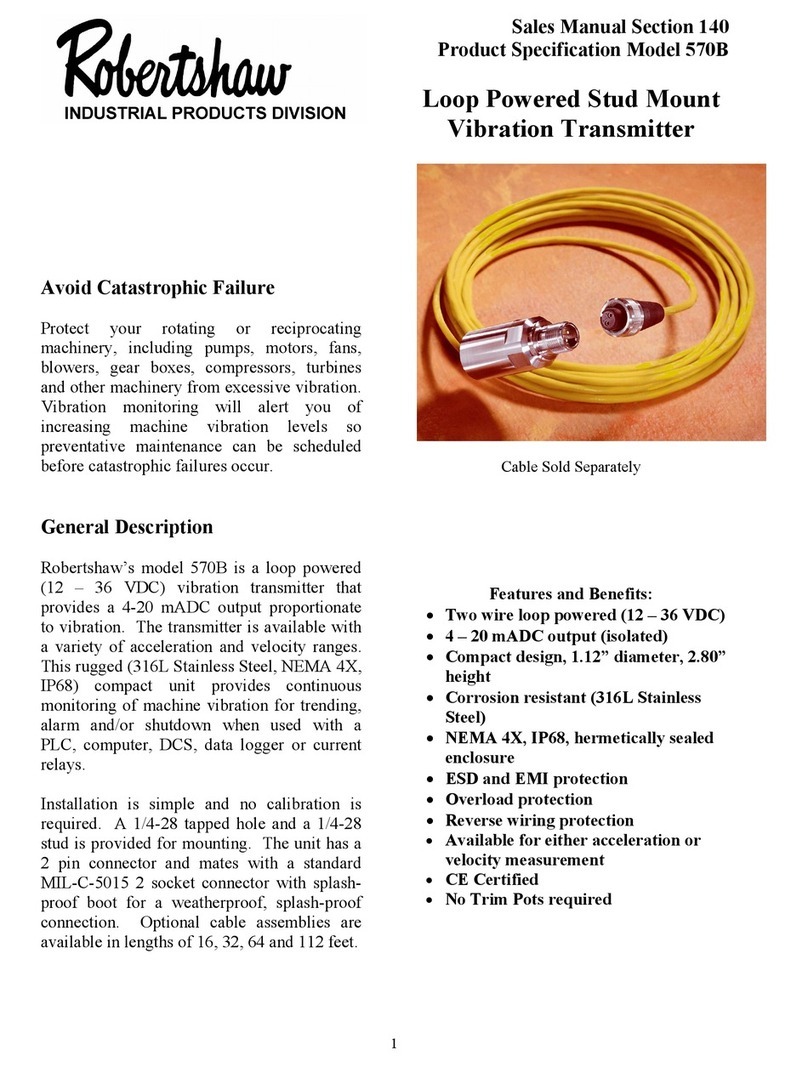
2
ORDERING INFORMATION
AND MODEL NUMBERS
Order by model number in Table 1.
Table 1 - Measurement
MODEL NO. DESCRIPTION
571A-A Acceleration, 0 - 5 G peak
571A-B Acceleration, 0 - 10 G peak
571A-C Acceleration, 0 - 20 G peak
571A-D Velocity, 0 - 0.5 IPS peak
571A-E Velocity, 0 - 1 IPS peak
571A-F Velocity, 0 - 2 IPS peak
Accessory Items
PART NO. DESCRIPTION
086568A0016* Standard IP66 Cable - 16 foot,
2 conductor shielded cable,
MIL-C-5015 2 socket connector with
splash-proof boot.
086568A0032 Standard IP66 Cable - same as above
except 32 foot
086568A0064 Standard IP66 Cable - same as above
except 64 foot
086568A0112 Standard IP66 Cable - same as above
except 112 foot
086568B0016** IP68 Cable - 16 foot, 2 conductor
shielded cable, MIL-C-5015 2 socket
connector with splash-proof boot
086568B0032 IP68 Cable - same as above except 32
foot
086568B0064 IP68 Cable - same as above except 64
foot
086568B0112 IP68 Cable - same as above except
112 foot
435KB311 Mounting stud for 1/4-28 tapped hole
(supplied with transmitter)
435KB311-01 Mounting stud for 3/8-24 tapped hole
435KB311-02 Mounting stud for M8 X 1.25-6G
tapped hole
435KB311-03 Mounting stud for M6 X 1.00-6G
tapped hole
* 16 foot standard cable is a stock item.
For other cables allow 6-8 weeks delivery.
Cable accessory must be ordered separately.
** For submersible applications use IP68 cable.
SPECIFICATIONS
DYNAMIC
Output (±5% of span) ……………..……....… 4 – 20 mADC
Vibration Range ………………………..…..…… See Table 1
Frequency Response:
- 3 dB …..………………….….…... 2 Hz – 2 kHz
Repeatability ………………………………..………..... ±2%
Resonant Frequency, mounted, nominal ………..…… 28 kHz
Transverse Sensitivity, max. …………..…………..…….. 5%
ELECTRICAL
Power Requirements (Two wire loop power):
Voltage Source …………….....14 VDC – 30 VDC
Loop Resistance …….…………………….……….see page 4
Grounding …………………………………….. case isolated,
internally shielded
Protection ………………….……… reverse wiring, overload,
ESD & EMI
ENVIRONMENTAL
Temperature Range …….…..…-40°to 85°C (-40°to 185°F)
Vibration Limit ……………………………………250 g peak
Shock Limit ………………………………….….2,500 g peak
Electromagnetic Sensitivity, equiv. g …………... 10 µg/gauss
Sealing ………………………….. hermetic, NEMA 4X, IP68
PHYSICAL
Sensing Element Design ………………….PZT ceramic/shear
Weight ……………………………………………..162 grams
Case Material ………………………….... 316L stainless steel
Case Rating ………………………………... IP68, NEMA 4X
Mounting ……………………………..…1/4 – 28 tapped hole
Supplied Accessories …………………..1/4-28 mounting stud
Output Connector ………………….….... MIL-C-5015, 2-pin
Pin A (white lead) ………………………. plus (+)
Pin B (black lead) ……………………….minus (-)
Cabling ……………………………… two conductor shielded
(see Accessory Items Table)
Torque Limit ………………………………... 30 in. lbs. Max.
Warranty ………………………………………………. 1 year






















